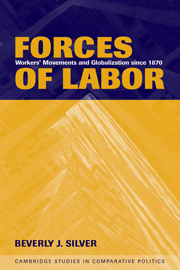Book contents
- Frontmatter
- Contents
- List of Figures
- List of Tables
- Preface and Acknowledgments
- 1 INTRODUCTION
- 2 LABOR MOVEMENTS AND CAPITAL MOBILITY
- 3 LABOR MOVEMENTS AND PRODUCT CYCLES
- 4 LABOR MOVEMENTS AND WORLD POLITICS
- 5 CONTEMPORARY DYNAMICS IN WORLD-HISTORICAL PERSPECTIVE
- Appendix A The World Labor Group Database: Conceptualization, Measurement, and Data Collection Procedures
- Appendix B Instructions for Recording Data from Indexes
- Appendix C Country Classifications
- References
- Index
- Cambridge Studies in Comparative Politics
4 - LABOR MOVEMENTS AND WORLD POLITICS
Published online by Cambridge University Press: 05 June 2012
- Frontmatter
- Contents
- List of Figures
- List of Tables
- Preface and Acknowledgments
- 1 INTRODUCTION
- 2 LABOR MOVEMENTS AND CAPITAL MOBILITY
- 3 LABOR MOVEMENTS AND PRODUCT CYCLES
- 4 LABOR MOVEMENTS AND WORLD POLITICS
- 5 CONTEMPORARY DYNAMICS IN WORLD-HISTORICAL PERSPECTIVE
- Appendix A The World Labor Group Database: Conceptualization, Measurement, and Data Collection Procedures
- Appendix B Instructions for Recording Data from Indexes
- Appendix C Country Classifications
- References
- Index
- Cambridge Studies in Comparative Politics
Summary
The previous two chapters focused on labor and global economic dynamics – especially the interrelationship between transformations in the organization/location of production, workers' bargaining power, and world-historical patterns of labor unrest. In this chapter, we shift the angle of vision, bringing to center stage the interrelationship between global politics and labor movements. For as we argued in Chapter 1, global economic processes are themselves deeply embedded in global political dynamics ranging from state formation and citizenship bounding to interstate conflict and world war.
In Chapter 1, we also suggested that the twentieth century – viewed through a Polanyian lens – traces a pendulum-like trajectory between the commodification of labor and the breakdown of established social compacts, on the one hand, and the decommodification of labor and the establishment of new social compacts, on the other hand. The first swing of the pendulum – the late-nineteenth- and early-twentieth-centuries movement toward the “commodification of labor” and the initial countermovement response from growing labor movements – is the focus of Section II of this chapter. Section V, in turn, focuses on the pendulum's swing back – the establishment of new national and international social compacts binding labor, capital, and states, which partially protected labor from the vagaries of an unregulated global market in the post–Second World War decades.
This swing of the pendulum was a response to four decades of world war, depression, explosive labor militancy, and worldwide revolutionary upheaval. This intervening period, characterized by a widening and deepening vicious circle of war and labor unrest, is the focus of Sections III and IV.
- Type
- Chapter
- Information
- Forces of LaborWorkers' Movements and Globalization Since 1870, pp. 124 - 167Publisher: Cambridge University PressPrint publication year: 2003

